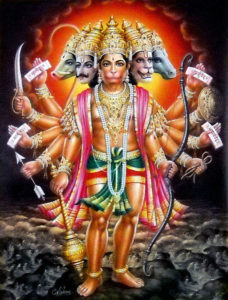 The worship of Shri Hanumaan can be performed in a variety of ways. Some have been outlined below. This saadhan or spiritual discipline is most effective. Some of the benefits of worshipping this form of Divinity are as follows:
The worship of Shri Hanumaan can be performed in a variety of ways. Some have been outlined below. This saadhan or spiritual discipline is most effective. Some of the benefits of worshipping this form of Divinity are as follows:
1. One is freed from the five kleshas (mental afflictions), which cause misery, perversion and negative tendencies. These kleshas are: avidyaa – ignorance, asmita – egoism, raag – attractions, dwesha – dislikes and abhinivesh – fear of death.
2. There is improvement in one’s physical health condition and mental stability; stamina is also increased.
3. One acquires the four purushaarthas or “fruits of human endeavour”. These are: dharma – righteousness, aarth – material wealth, kaam – legitimate sensual pleasures and moksha – liberation.
4. One acquires the power to remove obstacles and dangers of any kind.
5. One gains mastery over the animal instincts and evolves mentally to the state of Divine Consciousness.
6. Control of the mind is achieved, with constant focus and contemplation on Divinity.
7. Difficulties, mental depression and other stress-related conditions are reduced.
8. Wherever worship of Hanumaanji is performed, evil spirits are warded off.
Types of Hanumaan Worship
A. Mantra Recitation
Mantra-jaap or the continuous repetition of mantras (sacred Sanskrit formulae), can be performed by chanting loudly, whispering, repeating mentally or by writing. This practice is one form of niyam (positive virtues) that purifies the environment, builds positive vibrations, creates stability and lifts one to higher states of consciousness.
B. Chanting of Hanumaan Chaalisaa
Tulsidas composed the Hanumaan Chaaleesaa, a concise biography of Hanumaanji, in poetic form. The sage poet was very ill at the time. In his debilitated physical condition, he sang the praises of the Lord, in this poem of forty lines. Shortly after, he recovered. This composition is said to have miraculous powers, ensuring freedom, fulfillment, peace and happiness to the devotees who chant it. It is advisable that the Hanumaan Chaaleesaa be chanted on Tuesdays and Saturdays, if not every day.
C. Reading and Chanting the Sundar Kaand
The Sundar Kaand is the fifth volume of Shri Raamcharitramaanas, written by Goswami Tulsidas. It focuses mainly on the adventures of Shri Hanumaan in Lanka, on His search for Sita Devi, who was kidnapped by Ravan. In this volume the powers of a devotee of the Lord are depicted. Qualities such as patience, dependability, endurance and strength are all highlighted as Hanumaanji battles his way in the face of adversity.
Chanting the Sundar Kaand is a form of worship of Hanumaanji that helps one develop the qualities outlined above. It offers a beacon of hope for the devotee in search of spiritual enlightenment.
D. Hanumaan Jayanti
Hanumaan Jayanti is celebrated on the Poornima or full moon in the month of Chaitra (March-April). It marks the occasion when Hanumaanji was endowed with various boons from different deities making Him a source of unbounded power, strength and knowledge. Worship of Hanumaanji can be performed in the following way:
1. Simple Hanumaan pooja can be done.
2. Havan can be performed.
3. Hanumaan Chaalisaa, Sundar Kaand and other stotra can be chanted.
4. Charity can be offered.
Panchvaktra Hanumaan
Shri Hanumaan represents the embodiment of the highest potential that the mind can achieve. This form of divinity symbolizes the disciplined mind that achieves its goal with firmness, constancy and full surrender at the feet of the Master.
One of the clearest depictions of this symbol of the disciplined mind is discerned in the representation of Panchvaktra Hanumaan – the five-faced one. The faces of a horse, boar, lion, eagle and monkey are all positioned together facing the sky, north, west, south and east respectively. Each of these faces signifies different states of mind in the journey to perfection. The characteristics of these five states, according to Patanjali, in the following sutra, are:
‘Kshiptam mudham vikshiptam ekaagram niruddham iti chit bhibhumayah’
1. Kshiptam: raving, wandering, restless, disturbed state of mind
2. Mudham: dull, forgetful, lethargic
3. Vikshiptam: oscillating, occasionally steady, easily distracted
4. Ekaagram: one-pointed, tranquil, focused, concentrated
5. Niruddham: restrained, controlled, regulated, highly mastered
The first three states, as outlined in this verse, can be described as lower levels of thought, which deter mental and spiritual growth as well as self exploration. The ekaagra state is a positive one, nearer to inner stillness and conducive to concentration and meditation. The niruddha state is the highest and most disciplined state of mind. This is the state of mind of Hanumaanji, the state that earned Him the success He achieved in all His endeavours, in the cause of His Master Shri Raam. It is at this mental level of awareness that one is able to attain self realisation.
Hanumaan Mantras
Atulita baladhaanam Hema Shailaabha deham,
Danuja Vana Krishaanum Gyaani Naam Agraganayam,
Sakala Guna-nidhaanam Vaanaraa-naam-adheesham,
Raghupati Priya Bhakta Vaata Jaatam Namaami
I salute the son of the Wind-God, the abode of immense strength, possessing a body shining like a mountain of gold, a fire to consume the forest of the demon race, the foremost among the wise, storehouse of every excellence, the chief of the monkeys and Lord Raam’s noble devotee.
Bandau Pavana Kumaara
Khal Bana Paavaka Gyaana Ghana
Jaasu Hridaya Aagaar
Basahi Raam Shara Chaapa Dhar
I offer prostrations to Shri Hanumaan, the Son of the Wind, who is the storehouse of intelligence, who is like a fire to the forest of evildoers, in whose heart resides Shri Raam, armed with the bow and arrow.
Pavana Tanaya Sankat Harana
Mangal Moorati Roop
Raam Lakhan Sita Sahit
Hriday Basahau Sura Bhoop
O Son of the Wind-God, destroyer of difficulties, embodiment of blessings, who has an auspicious form and who is supreme among the Divine, dwell in my heart, along with Shri Raam, Lakshman and Sita Devi.
Hanumaan Gaayatri:
Om Anjaneya Vidmahe
Vaayu-putraaya Dheemahi
Tanno Hanumatey Prachodayaat
Let me meditate on the son of Anjana.
Oh very strong one, give me higher intellect.
May Hanumaan illumine my mind.




Ankita Pathak
Great information. Your post delivered everything that people need to know. Great translation of all the Sanskrit mantras into English. Excellent work